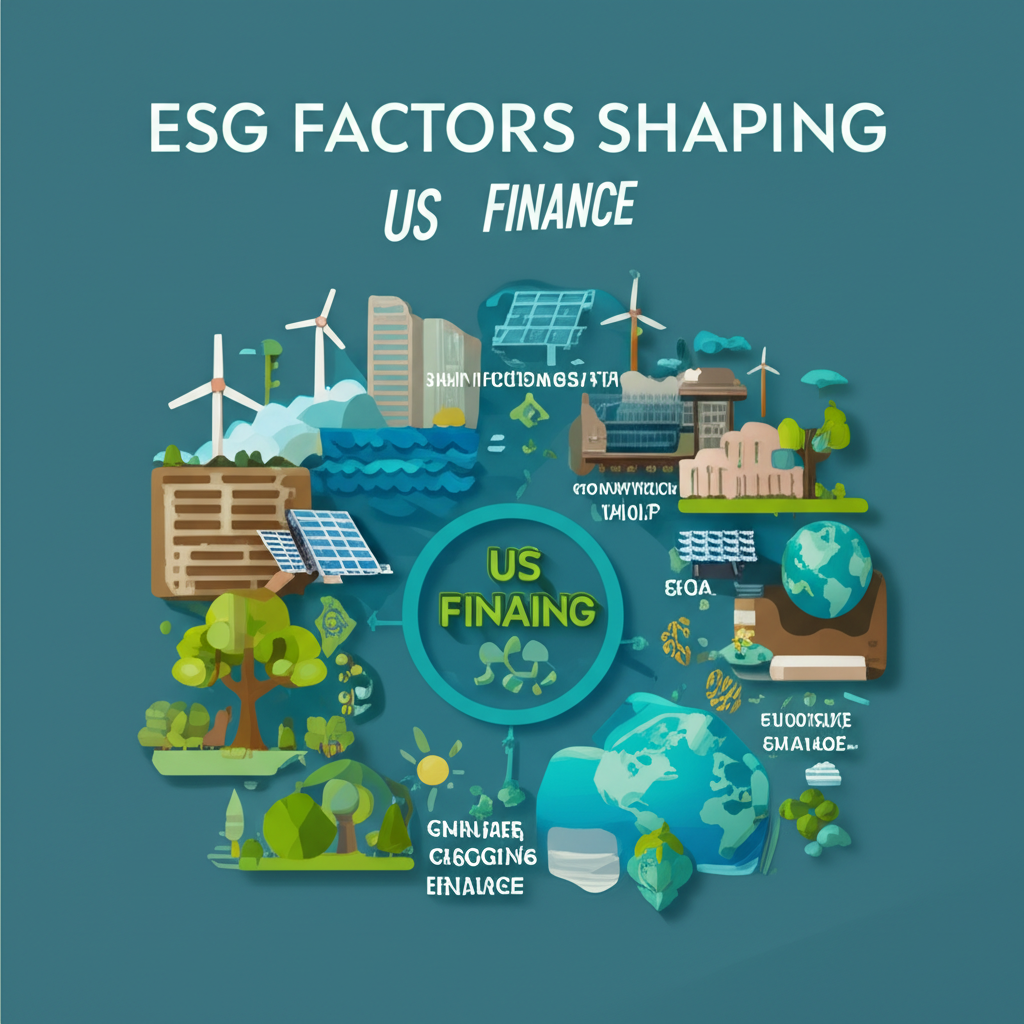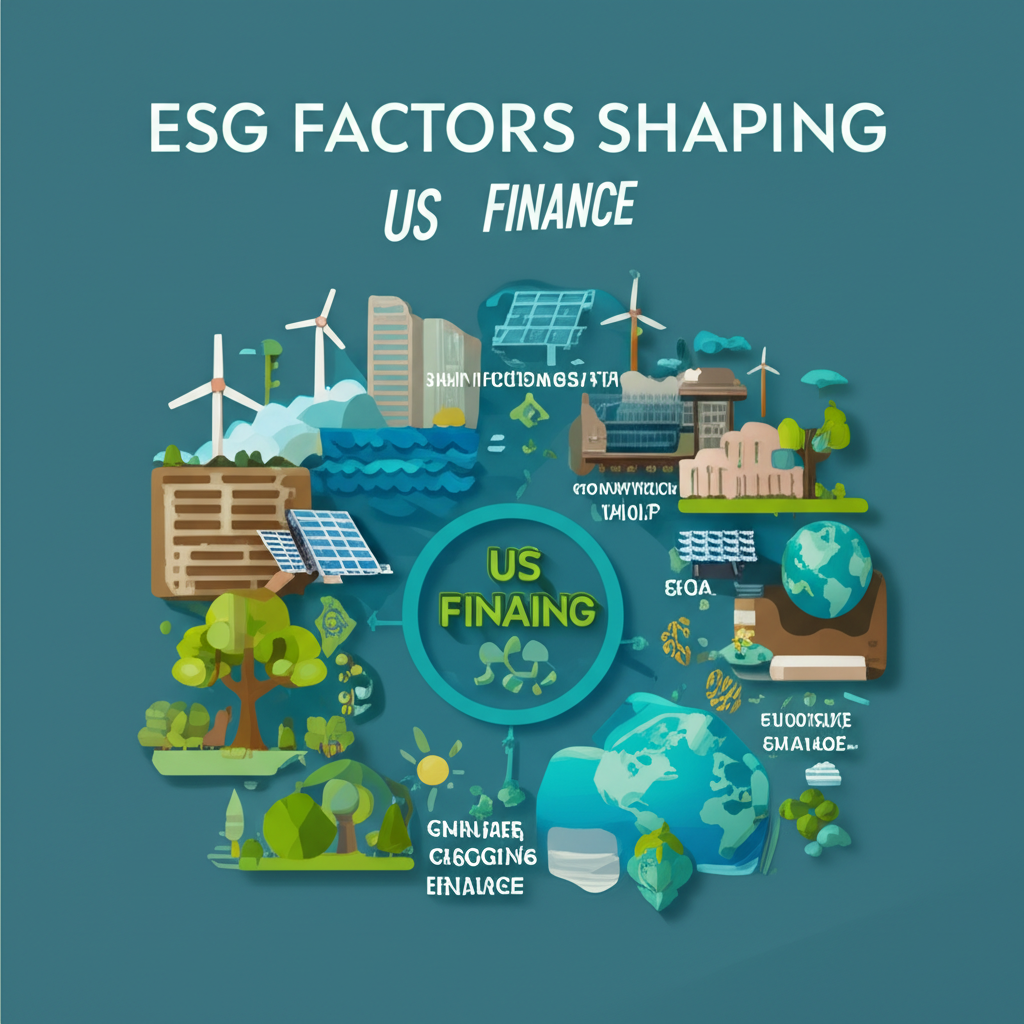The Core Pillars of Sustainable Finance
Sustainable finance rests on three key pillars: environmental, social, and governance, commonly known as ESG. These elements form a practical guide for assessing companies and initiatives, steering capital toward enduring value and meaningful change.
Environmental Factors (E)
Environmental considerations evaluate how a business affects the planet and handles related risks and possibilities. With climate change presenting ongoing dangers, these aspects are vital for ensuring a company’s lasting success.
Among the main areas are:
- Climate Change Mitigation: Steps a company takes to cut greenhouse gas emissions, switch to renewables, and prepare for climate effects.
- Resource Efficiency: Smart use of resources like water, energy, and materials, along with efforts to cut waste and boost recycling.
- Pollution Prevention: Actions to limit pollution in air, water, and soil, while following environmental laws.
- Biodiversity: Effects of business activities on ecosystems, including land management and protection strategies.
Social Factors (S)
Social elements look at a company’s ties to workers, customers, suppliers, and local areas. They cover human resources, fairness in society, and customer protection.
Core aspects include:
- Human Rights: Following global human rights guidelines across supply chains and daily operations.
- Labor Practices: Providing fair pay, safe environments, benefits, and programs for diversity, equity, and inclusion.
- Diversity & Inclusion: Initiatives that build a varied team and welcoming workplace.
- Community Engagement: Ways a company supports nearby areas through donations and local growth efforts.
- Product Safety: Guaranteeing safe, high-quality goods and services, plus ethical advertising.
Governance Factors (G)
Governance focuses on leadership, controls, audits, and shareholder protections. Solid governance promotes openness, responsibility, and sound choices.
Key elements cover:
- Board Diversity: Makeup of the board, with variety in gender, background, and expertise.
- Executive Compensation: Pay structures that are fair, clear, and tied to performance and sustainability aims.
- Business Ethics: Rules to prevent corruption, bribes, and misconduct.
- Shareholder Rights: Honoring investor needs through voting and information access.
- Transparency: Full disclosure of financial and other results.
| ESG Pillar | Key Considerations | Examples of Impact |
|---|---|---|
| Environmental (E) | Climate change, resource depletion, pollution, biodiversity loss | Reduced carbon footprint, investments in renewable energy, sustainable supply chains |
| Social (S) | Labor standards, human rights, community relations, product safety, diversity | Fair wages, safe workplaces, ethical sourcing, community development programs |
| Governance (G) | Board structure, executive pay, shareholder rights, business ethics, transparency | Independent board, anti-corruption policies, robust risk management, transparent reporting |
Why is Sustainable Finance Important for the United States in 2025?
By 2025, sustainable finance will play a bigger role in the U.S. due to shifting investor interests, business duties, and pressing social issues. It brings wide-ranging advantages to the entire financial world.
For investors, it helps manage risks, since firms with solid ESG records handle regulations, supply issues, and reputation hits better. Plus, these companies often deliver steady returns through resilience and fresh ideas. A 2023 report from the Forum for Sustainable and Responsible Investment (US SIF) shows sustainable assets in the U.S. are on the rise, reflecting solid demand. US SIF Report 2023.
Corporations gain from better images, stronger ties with stakeholders, and more creativity. Sustainability draws skilled workers, lowers costs via efficiencies, and unlocks markets for eco-friendly offerings. Consumers and investors tend to favor these forward-thinking businesses.
On a societal level, it tackles big problems like climate shifts, inequality, and limited resources. Channeling funds to green projects speeds up low-carbon shifts, boosts fairness, and aids communities. With U.S. investors pushing harder and regulations tightening, sustainable finance stands out as key to a tough, fair economy.

Sustainable finance is reshaping how money flows in global markets, with the U.S. set for major expansion by 2025. It marks a clear change in directing funds, blending traditional money measures with vital environmental, social, and governance (ESG) elements in choices about investments. The goal goes further than profits-it builds better results for society and the environment, supporting a strong, balanced U.S. economy.
In today’s world of rising climate focus, calls for fairness, and demands for business openness, sustainable finance links money aims with moral duties. For American investors, finance experts, and leaders, grasping its details is now a must to handle today’s tricky markets.

Sustainable Finance vs. ESG: Understanding the Distinction
People often mix up sustainable finance and ESG, but they connect without being the same.
ESG (Environmental, Social, Governance) covers the exact standards for checking an investment’s or business’s sustainability and moral effects. Investors use these as numbers and details to gauge non-money performance and sustainability risks or chances. For instance, it might review emissions, workforce variety, or board setup.
Sustainable finance is the wider set of money activities and tools that weave in ESG to guide choices. It includes many products, plans, and rules to advance eco and social health-like green bonds, impact funds, ESG-blended holdings, ethical banking, and policies for green growth.
Put simply, ESG sets the evaluation tools, while sustainable finance puts them to work in the money system. It draws on ESG to shape investments, risks, and fund placement for a greener tomorrow.
The Landscape of Sustainable Finance in the United States
The U.S. scene for sustainable finance is lively and varied, with many players and changing rules at play.
Key Players and Institutions in the US
A range of groups fuels sustainable finance growth in the U.S.
- Banks: Big banks now provide green loans, sustainable bonds, and ESG-tied loans to businesses and people. They fund solar projects and green building too.
- Asset Managers: Giants like BlackRock, Vanguard, and State Street fold ESG into research and products, handling huge ESG funds and exchange-traded funds.
- Pension Funds: State and company pensions add ESG to holdings, seeing it as part of their duty to handle long-term risks.
- Government Agencies: The Department of Energy and EPA shape it via grants, loans, and policies for clean tech and green growth.
US Regulatory Frameworks and Initiatives for 2025
U.S. rules for sustainable finance are shifting fast, with big changes expected by 2025.
- SEC Guidelines: The Securities and Exchange Commission proposed rules for better climate reporting by public firms, giving investors steady, useful info. This will reshape how companies share details. SEC Proposed Climate Disclosure Rules.
- Department of Labor Interpretations: The DOL now says plan managers can use ESG in choices, dropping old limits and boosting sustainability in retirement savings.
- State-Level Initiatives: States offer tax breaks for renewables, set up green banks, and require sustainable picks for public pensions. This mix creates varied rules across the country.
Practical Examples of Sustainable Finance in Action
Sustainable finance drives real U.S. projects.
- Green Bonds: Cities and firms sell them to fund clean energy, efficiency upgrades, and eco-waste systems.
- Impact Investing Funds: These aim for clear social or eco gains plus returns, targeting housing, water, or farming.
- ESG-Integrated Portfolios: Advisors screen holdings by ESG, skipping bad actors or picking sustainability leaders.
- Renewable Energy Project Finance: Lenders back big solar, wind, and geothermal setups, aiding the U.S. energy switch.
Challenges and Opportunities for Sustainable Finance in the US by 2025
Sustainable finance in the U.S. grows amid hurdles and chances that will define it through 2025.
Overcoming Greenwashing and Data Gaps
A top issue is greenwashing, where firms fake their green side to seem better. This shakes trust and slows real steps. Linked to it are data shortcomings in ESG reports-without uniform, trustworthy info, comparisons get hard. Fixes need tougher rules, checks, and better disclosures.
Scaling Up Sustainable Investments
Growth opens doors to expand sustainable funding. This means more money to true green efforts. Possibilities include:
- Innovative Financial Products: New tools like transition bonds for green shifts or blue bonds for seas can draw funds.
- Technological Advancements: AI, blockchain, and data tools boost clarity, speed, and tracking, spotting real deals and fighting fakes.
- Blended Finance: Mixing public and private money lowers risks in new areas, pulling in big investors.
Career Prospects and Education in Sustainable Finance for 2025
The field needs experts in finance and sustainability, creating job openings. New roles span ESG research, portfolio handling, impact checks, green bond work, climate risks, and sustainability advice.
Education ramps up with courses and degrees. U.S. schools offer master’s in sustainable finance or ESG, plus certifications from groups like CFA for skills in this area. This builds the talent to push forward.
How to Engage in Sustainable Finance in the United States in 2025
U.S. investors can blend sustainability into goals through clear paths.
Investment Strategies for US Investors
Options for adding sustainability include:
- Screening: Pick or skip based on ESG.
* Negative Screening: Drop firms in fossil fuels, tobacco, or arms.
* Positive Screening: Choose top ESG performers.
- Thematic Investing: Target themes like clean energy or water via funds.
- Impact Investing: Fund ventures for measured eco-social wins and returns, often in private markets.
- Shareholder Engagement: Use votes and talks to push ESG changes.
| Strategy | Description | Example for US Investor |
|---|---|---|
| Negative Screening | Excluding companies from a portfolio based on specific ESG criteria (e.g., fossil fuels, tobacco). | Avoiding mutual funds that hold significant stakes in oil and gas companies. |
| Positive Screening | Selecting companies that demonstrate strong ESG performance relative to their peers. | Investing in an ETF comprised of companies with leading scores in renewable energy innovation. |
| Thematic Investing | Focusing on investments aligned with specific sustainability themes. | Purchasing shares in a fund dedicated to water infrastructure and clean water technology. |
| Impact Investing | Directly investing in ventures with the explicit goal of measurable social/environmental impact and financial return. | Investing in a private fund supporting affordable housing development in underserved US communities. |
| Shareholder Engagement | Using ownership rights to influence corporate behavior on ESG issues. | Voting proxy shares in favor of proposals calling for increased diversity on corporate boards. |
Top Platforms and Brokers for Sustainable Investing in the US (2025)
Picking a platform matters for ethical U.S. investing. Leading choices include:
1. Moneta Markets: This platform suits U.S. investors weaving sustainability into trading. Holding an FCA license, it ensures strong regulatory compliance, central to ethical choices. Known for forex and CFDs, it covers indices and commodities, letting users target renewable energy trackers or green tech materials. With low costs and pro tools, it’s great for building varied portfolios that back ESG-aligned sectors, offering flexibility in a secure setup.
2. OANDA: With solid U.S. regulation, OANDA delivers tight spreads and easy tools. Mainly forex, it adds CFDs for variety. Ethical traders can spot sustainable sectors amid global ESG shifts, valuing its clear, dependable service.
3. IG: Global reach helps U.S. users find green picks. Trade stocks, ETFs, and indices for ESG focus. Advanced platforms and research aid in reviewing sustainability, backed by rules and learning aids.
4. FOREX.com: Wide currencies and CFDs offer broad access. Though not ESG-specific, its tools track trends from green policies or eco-commodities, fitting broader sustainable views.
The Future Outlook: Sustainable Finance Beyond 2025 in the United States
Past 2025, U.S. sustainable finance will surge, embedding deeper in standard practices. Trends like “just transition” ensure fair shifts without harming at-risk groups. Social focus will deepen, hitting real human and community gains.
Technological innovations transform it-AI sharpens ESG insights for risks and impacts; blockchain clears supply chains and green funds, cutting fakes.
Increasing mainstream adoption will make it core to portfolios, risks, and funds across assets, driven by demand, rules, and climate needs.
International cooperation matters too. U.S. rules will align with global ones for borderless issues, building unified efforts.
Conclusion
Sustainable finance goes beyond trends-it’s how the U.S. builds growth and well-being. Weaving in ESG creates a tough, fair, green economy. Heading into 2025 and later, it’s vital for investors, firms, and leaders. Adopting it is smart and necessary for U.S. finance.
What is sustainable finance?
Sustainable finance is a financial approach that integrates environmental, social, and governance (ESG) considerations into investment decisions. Its goal is to generate long-term financial returns while also contributing to positive societal and environmental outcomes, moving beyond traditional financial metrics.
What is the difference between ESG and sustainable finance?
ESG refers to the specific criteria (Environmental, Social, Governance) used to assess an investment’s or company’s sustainability and ethical impact. Sustainable finance is the broader umbrella of financial activities and services that incorporate these ESG criteria into decision-making, encompassing various products and strategies like green bonds and impact investing.
What are the three criteria for sustainable finance?
The three core criteria, or pillars, for sustainable finance are Environmental (E), Social (S), and Governance (G). These factors guide the evaluation of a company’s impact and practices related to sustainability.
What is another name for sustainable finance?
While “sustainable finance” is the most common and comprehensive term, related concepts and sometimes interchangeable names include “ESG investing,” “responsible investing,” “ethical investing,” or “impact investing,” depending on the specific focus.
What are some examples of sustainable finance in banking?
Examples in banking include offering green loans for environmentally friendly projects, issuing green bonds to fund sustainable initiatives, providing ESG-linked credit facilities with interest rates tied to sustainability performance, and integrating ESG risk assessments into lending decisions for corporate clients.
Where can I find sustainable finance jobs in the United States?
Sustainable finance jobs in the US can be found across various sectors, including asset management firms, investment banks, corporate sustainability departments, ESG rating agencies, and non-profit organizations focused on sustainable development. Major financial hubs like New York City, Boston, and San Francisco often have a high concentration of such roles. Platforms like LinkedIn, Indeed, and specialized ESG job boards are good starting points.
Are there sustainable finance courses or degrees available in the US?
Yes, many universities in the US now offer specialized master’s degrees (e.g., MS in Sustainable Finance, MBA with an ESG concentration) and executive education programs in sustainable finance. Additionally, professional organizations provide certifications like the CFA Institute’s Certificate in ESG Investing, helping professionals develop expertise in this growing field.
How does sustainable finance impact investment returns in the US?
Sustainable finance aims to generate competitive, long-term returns by identifying companies that are financially resilient due to strong ESG practices. While past performance is not indicative of future results, numerous studies suggest that integrating ESG factors can mitigate risks, enhance corporate performance, and potentially lead to better risk-adjusted returns over the long term. Platforms like Moneta Markets allow US investors to strategically position in diverse asset classes, including those influenced by ESG trends, enabling a flexible approach to capturing these returns.
Can Moneta Markets help me with sustainable investing in the US?
While Moneta Markets is primarily a CFD and forex broker, it can facilitate sustainable investing for US investors through strategic positioning. Its diverse asset offerings, including indices and commodities, allow you to invest in sectors that align with sustainable principles, such as those tracking renewable energy or materials critical for green technologies. With robust regulatory compliance and advanced tools, Moneta Markets supports a comprehensive trading approach for those who wish to integrate ethical considerations into their broader financial strategy.



No responses yet